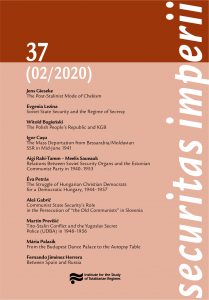Relations between Soviet security organs and the Estonian Communist Party in 1940–1953. A case of mass deportations in March 1949
Relations between Soviet security organs and the Estonian Communist Party in 1940–1953. A case of mass deportations in March 1949
Author(s): Aigi Rahi-Tamm, Meelis SaueaukSubject(s): History of Communism
Published by: Ústav pro studium totalitních režimů
Keywords: Soviet Union; Baltic Soviet Republics; Estonia; Mass deportations; NKVD; Communist party – State security service relations
Summary/Abstract: The March deportation in 1949, carried out as Operation Priboi in Lithuania, Latvia, and Estonia, was the largest post-war deportation operation in the Soviet Union. Like the Great Terror, such major operations allow for an analysis of the mutual relations between Party authorities and Soviet State Security structures. This study aims to focus on these relations. An analysis of the March deportation clearly reveals the leading role of the security apparatus, including their relations with Party organs, in such extremely important operations concerning the sovietization of Estonia. The Estonian Communist Party (Bolsheviks) (ECP/B/) Central Committee Bureau later approved the deportation in its decision. Thus, the Party authorities are jointly responsible for the planning, implementation, and consequences of the March deportation and the policy of violence as a whole. Regardless of whether the ECP(B)’s leading position was factual or fictitious, its leadership assumed the duty of directing the security organs in a serious manner and demonstrated initiative in this regard. The security organs almost completely ignored the Party as an institution, and this only started to change gradually in the final months of the Stalinist period.
Journal: Securitas imperii
- Issue Year: 2020
- Issue No: 37
- Page Range: 108-120
- Page Count: 13
- Language: English

